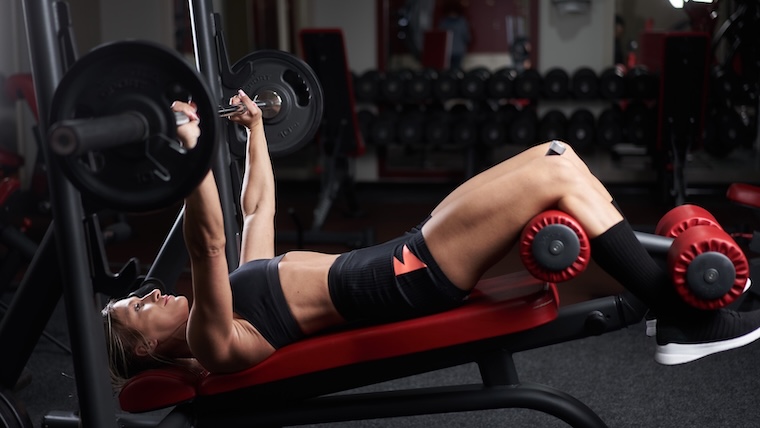Breaking exercises into sets provides muscle recovery time, so how many sets are optimal for muscle growth? Is less volume more beneficial for specific muscle groups? A recent study on chest hypertrophy suggests that one set might be sufficient for stimulating chest growth.
In their analysis, House of Hypertrophy interpreted these scientific findings, exploring the factors contributing to varying results, and offered advice on structuring sets to maximize muscle hypertrophy.
Adequate Set Range for Chest Hypertrophy
A May 2025 study examined muscle growth in 15 untrained men over 12 weeks using the unilateral pec deck. Participants trained twice a week, performing one set per session with one arm (two weekly sets), while the other arm completed three sets per session (six weekly sets). (1) Below is the rep range that was listed from these subjects:
- Weeks 1-2: 18-20
- Weeks 3-4: 15-17
- Weeks 5-6: 12-14
- Weeks 7-9: 10-12
- Weeks 10-12: 8-10
Before the training began, researchers measured the muscle thickness of the pectoralis major’s clavicular and sternocostal heads to determine how different chest regions might respond to training. The results revealed that both areas of the pectoralis experienced significant growth during the training sessions. The clavicular and sternocostal heads grew at similar rates, regardless of the training protocol.
All sets were performed to volitional concentric failure, yet the study found that participants who completed three times the number of sets did not achieve greater muscle gains. This challenges previous research suggesting that muscle growth can be enhanced by increasing the number of sets. (2)(3)(4)(5)

Consider that various factors may have influenced the outcomes of this study. These factors include:
- Limb size of participants.
- Participants who did things outside the study that impaired the stimulus to one limb over the other.
- Measurement error that could influence one limb over the other.
- Some individuals may experience similar growth between one and three sets.
Simulations & Meta-Analysis
Small sample sizes can lead to unreliable conclusions, but simulations can clarify. James Krieger conducted a simulation to explore why findings from resistance training studies often differ. His analysis compared groups from five studies, each using varying training volumes.
Only one study produced results resembling the true population effect — increased volume leading to increased growth — while the others displayed inconsistent patterns. For example, moderate training volumes performed the best in one study but the worst in another.
To address these biases, a meta-analysis — combining data from small sample studies to enhance statistical power — can offer more reliable insights. This explains why mixed results are common in such research.
When reviewing a single study…try to detail the broader literature to get closer to the truth. Each study is ultimately a single data point belonging to a future meta-analysis.
—House of Hypertrophy
Meta-Analysis on Sets & Hypertrophy
The latest meta-analysis on set range and hypertrophy reveals that performing more sets generally leads to greater muscle growth, although with diminishing returns. (6) Consider key factors that challenge the idea that higher training volumes are always optimal. Lower volumes can still yield significant progress, proving that more isn’t always better.
Individual Differences
Individual differences might determine whether a single set is sufficient for hypertrophy. Factors such as physiological mechanisms and lifestyle habits can significantly influence outcomes.
For instance, during periods of high stress, a person’s ability to handle higher training volumes may be compromised, affecting their overall response to exercise. The best approach is to use the average effects reported in the literature as a baseline. Training volume can and should be adjusted when necessary.
This study focused on growth observed at a single point on the chest rather than across multiple regions, which could yield varying outcomes. Moreover, a single study cannot confirm that pec decks alone effectively maximize upper chest growth.
Despite limited research on chest growth in different regions of the pecs, incorporate exercises targeting the upper pecs, such as the incline press, for more balanced development.
More In Research
- Build Muscle, Lose Fat — Intermittent Fasting, Resistance Training, or Both?
- Train Past Failure for the Thickest Calves
- Is the Overhead Press Worth It for Hypertrophy?
References
- Pinto, M. D., Ughini, C., Nunes, J. P., Cadore, E. L., & Pinto, R. S. (2025). Pectoralis Clavicular and Sternocostal Thicknesses Increase Similarly in Response to One and Three Sets of Pec Deck Resistance Training in Untrained Young Men. Journal of strength and conditioning research, 39(5), 523–530. https://doi.org/10.1519/JSC.0000000000005045
- Sooneste, H., Tanimoto, M., Kakigi, R., Saga, N., & Katamoto, S. (2013). Effects of training volume on strength and hypertrophy in young men. Journal of strength and conditioning research, 27(1), 8–13. https://doi.org/10.1519/JSC.0b013e3182679215
- Mitchell, C. J., Churchward-Venne, T. A., West, D. W., Burd, N. A., Breen, L., Baker, S. K., & Phillips, S. M. (2012). Resistance exercise load does not determine training-mediated hypertrophic gains in young men. Journal of applied physiology (Bethesda, Md. : 1985), 113(1), 71–77. https://doi.org/10.1152/japplphysiol.00307.2012
- Radaelli, R., Wilhelm, E. N., Botton, C. E., Rech, A., Bottaro, M., Brown, L. E., & Pinto, R. S. (2014). Effects of single vs. multiple-set short-term strength training in elderly women. Age (Dordrecht, Netherlands), 36(6), 9720. https://doi.org/10.1007/s11357-014-9720-6
- Rønnestad, B. R., Egeland, W., Kvamme, N. H., Refsnes, P. E., Kadi, F., & Raastad, T. (2007). Dissimilar effects of one- and three-set strength training on strength and muscle mass gains in upper and lower body in untrained subjects. Journal of strength and conditioning research, 21(1), 157–163. https://doi.org/10.1519/00124278-200702000-00028
- Pelland, N. J., Remmert, N. J., Robinson, N. Z., Hinson, N. S., & Zourdos, N. M. (2024). The Resistance Training Dose-Response: Meta-Regressions Exploring the Effects of Weekly Volume and Frequency on Muscle Hypertrophy and Strength Gain. The Resistance Training Dose-Response: Meta-Regressions Exploring the Effects of Weekly Volume and Frequency on Muscle Hypertrophy and Strength Gain. https://doi.org/10.51224/srxiv.460
Featured image via Shutterstock/Slatan